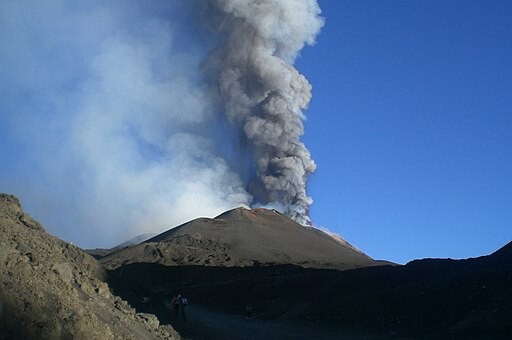Volcanoes are openings on the Earth's surface that allow lava, small rocks, and steam to erupt from its interior. Explosive volcanic eruptions can send ash, gas, and magma high up into the atmosphere, but can these explosions be strong enough to send materials into space?

Can Volcanic Eruptions Reach the Atmosphere?
How high an explosive volcano can go depends on the size of the eruption as well as the size of the debris. A strong eruption tends to send materials further, while extensive materials from any eruption do not get thrown as far as the finer ones.
Volcanic eruptions can be classified according to style, which is controlled by the characteristics of the erupting magma and the volume and rate at which it is emitted. They can be explosive, where ash, gas, and lava are sent high up in the atmosphere, or effusive, where magma can form lava flows.
During an explosive volcanic eruption, an eruption column or eruption plume forms clouds of superheated ash and tephra suspended in emitted gases. The volcanic materials in the vertical column can rise many kilometers into the air above the volcanic vent.
The eruption column will stop rising once it reaches a denser altitude than the surrounding air. The height that an eruption column can get can be affected by several factors. These include the diameter of the volcanic vent, the gas content of the magma, and the velocity at which it is ejected. Other factors are the winds and the local thermal temperature gradient.
In theory, the maximum achievable column height of an eruption column is thought to be 34 miles (55 kilometers). In reality, column heights that range from 1.2 to 28 miles (2 to 45 kilometers) have been observed. Eruption columns over 12 to 25 miles (20 to 40 kilometers) can break through the tropopause and inject particulates into the stratosphere.
This phenomenon was observed during the eruption of the Hunga Tonga-Hunga Ha'apai volcano in 2022. The volcanic activity created waves reverberating around the Earth and reaching 62 miles (100 kilometers) into the ionosphere. This historical blast, the most powerful eruption of the 21st century, triggered atmospheric gravity waves that reached the edge of space.
Collapse of Eruption Column
Once the column reaches the atmosphere, its ashes and aerosol components are quickly removed by precipitation. To double the column height, the volcanic eruption should eject 16 times as much material per second.
The columns can get so loaded with dense materials that they become too heavy to be supported by air convection, leading to eruption column collapse. This can occur if the rate at which magma erupts increases to a point where insufficient air is insufficient to support it.
If this happens, the materials in the eruption column will fall under the influence of gravity. As a result, the eruption column falls down the volcano's slopes and forms pyroclastic flows or surges.
RELATED ARTICLE: NASA Satellite Shows How Hunga Tonga Volcanic Eruption Released Water to Stratosphere; Trapped Vapor in Atmosphere Warms the Earth
Check out more news and information on Volcanic Eruptions in Science Times.




![Grown Mice With Hybrid Brains Can Smell Using Rat’s Neurons [Study]](https://1721181113.rsc.cdn77.org/data/thumbs/full/53431/89/56/50/40/grown-mice-with-hybrid-brains-can-smell-using-rat-s-neurons-study.jpeg)





!['Cosmic Glitch' in Einstein's Theory of General Relativity Could Be Explained in This New Scientific Tweak [Study]](https://1721181113.rsc.cdn77.org/data/thumbs/full/53435/258/146/50/40/cosmic-glitch-in-einsteins-theory-of-general-relativity-could-be-explained-in-this-new-scientific-tweak-study.jpeg)



